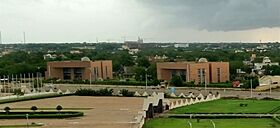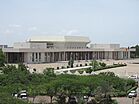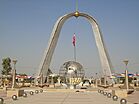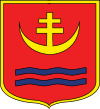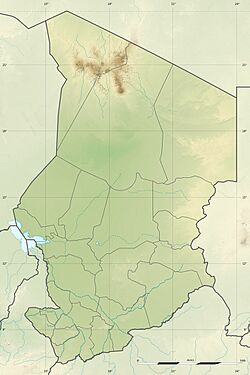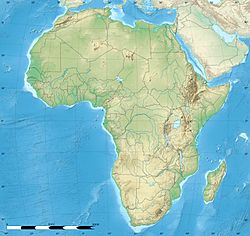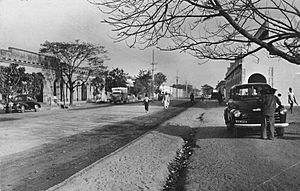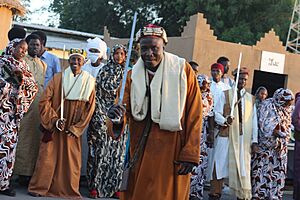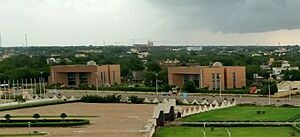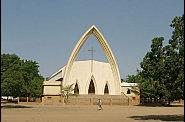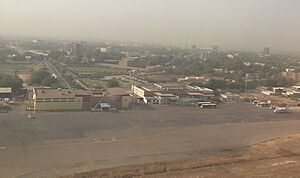N'Djamena facts for kids
Quick facts for kids
N'Djamena
Fort-Lamy
|
||
|---|---|---|
|
Top: N'Djamena skyline; Middle: National Assembly of Chad, Nation Square (Place de la Nation); Bottom: Presidential Palace, Downtown N'Djamena
|
||
|
||
| Country | ||
| Area | ||
| • Capital city | 104 km2 (40 sq mi) | |
| • Metro | 166 km2 (64 sq mi) | |
| Elevation | 298 m (978 ft) | |
| Population
(2009 census)
|
||
| • Capital city | 807,000 | |
| • Density | 9,148/km2 (23,690/sq mi) | |
| • Metro | 1,605,696 | |
| Time zone | UTC+01:00 (West Africa Time) | |
| • Summer (DST) | (Not Observed) | |
| Area code(s) | 235 | |
| HDI (2021) | 0.432 low · 1st |
|
N'Djamena is the capital and largest city of Chad. It is also a special region, divided into 10 areas called arrondissements.
This city is the main place for business in Chad. Its biggest industries are processing meat, fish, and cotton. It is also a big market where people buy and sell livestock, salt, dates, and grains.
N'Djamena is a port city. It sits where the Logone River and the Chari River meet. Across the river in Cameroon is the city of Kousséri. In 2014, N'Djamena had over 1 million people living there.
Contents
A Look at N'Djamena's History
N'Djamena was first called Fort-Lamy. A French commander named Émile Gentil founded it on May 29, 1900. He named it after Amédée-François Lamy, an army officer who died in a battle nearby. The city quickly became an important trading center and the capital of the region.
During World War II, the city's airport was very important. The French used it to move soldiers and supplies. On January 21, 1942, a German plane bombed the airport. It destroyed fuel and ten aircraft.
Fort-Lamy got its first bank in 1950. The Bank of West Africa (BAO) opened a branch there.
On April 6, 1973, President François Tombalbaye changed the city's name to N'Djamena. This new name comes from an Arabic village name, Niǧāmīnā, which means "place of rest." This change was part of his plan to make names more African.
The city faced tough times in the late 1970s and early 1980s. It was partly destroyed during a civil war in 1979 and again in 1980. Many people left the city and found safety across the Chari River in Cameroon. They started coming back in 1981–82 after the fighting stopped. For a few years, daily life was hard, and schools were closed.
The city's population grew a lot over the years. In 1937, only about 10,000 people lived there. By 1968, after Chad became independent, the population reached over 126,000. In 1993, it was more than half a million. Many people moved to N'Djamena seeking safety during times of trouble. By the early 2010s, the city's population passed one million.
N'Djamena has also been attacked by rebel groups. In April 2006, a rebel attack was stopped. In February 2008, rebels attacked again, but the city's defenses held.
Where is N'Djamena?
N'Djamena is located at 12°06′36″N 15°03′00″E / 12.11000°N 15.05000°E. It sits where the Chari and Logone rivers meet.
The city is mainly an administrative center. It has a main business area called the Nassara Strip. There are also many neighborhoods like Mbololo, Chagoua, Paris Congo, and Moursal. The main shopping street is Avenue Charles de Gaulle.
N'Djamena's Environment
N'Djamena is known as Africa's most polluted city.
Climate in N'Djamena
N'Djamena has a hot semi-arid climate. This means it has a short wet season and a long dry season. Even though it gets about 510 millimeters (20 inches) of rain each year, much of this water evaporates quickly. This is why it's called semi-arid.
The wet season is from June to September, with the most rain in August. The dry season lasts for the other eight months. N'Djamena is one of the hottest big cities in the world. Only in August do the average high temperatures stay below 32°C (90°F). The hottest months are usually from March to May, just before the heavy rains begin.
Economy and Work in N'Djamena

Most of N'Djamena's economy comes from farming. About 80% of the people in the city work in farming-related jobs. This includes growing crops and raising livestock. Because of this, the economy depends a lot on good weather. If there isn't enough rain, the economy can struggle.
N'Djamena gets money help from groups like the World Bank and the African Development Bank. There is a need for skilled workers in N'Djamena, especially in the oil and gas industries. People are also needed for foreign aid groups, medical services, and English teaching. Residents in N'Djamena can pay up to 60% of their income in taxes.
Culture and Attractions
There are many interesting places to visit in N'Djamena:
- The Chad National Museum
- The Al-Mouna Cultural Center
- Our Lady of Peace Cathedral
- Several mosques
Inside the Chad National Museum, you can see part of a skull from an ancient human ancestor called Sahelanthropus. Locals call it "Toumaï." This skull was found in northern Chad and is very important for understanding early human history. Watching the sunset over the Chari River can also be amazing. N'Djamena was named the Capital of Islamic Culture in 2009.
Education in N'Djamena
Education in N'Djamena is important, even though it can be hard to get. Since Chad became independent in 1960, schooling has been required and free. However, less than half of elementary-aged children in Chad get to go to school. It's even harder for children to get an education when the city is not stable.
After elementary school, some students go to a university. N'Djamena has two universities:
- The University of N'Djamena, built in 1971, teaches in French.
- King Faisal University - Chad, built in 1991, teaches in Arabic.
There are also secondary schools like Lycée Félix Éboué and Lycée technique commercial. The Lycée Montaigne de N'Djamena is a French international school. While secondary school is required in Chad, only about 68% of students over 12 attend. Of those, 70% go to school in N'Djamena. Many students in international schools are children of diplomats or people working for international organizations.
Places of Worship
N'Djamena has many places of worship. Most of them are Muslim mosques. There are also Christian churches and temples. These include the Roman Catholic Archdiocese of N'Djaména (Catholic Church), the Evangelical Church of Chad, and Christian Assemblies in Chad.
Getting Around N'Djamena
Roads and Highways
N'Djamena is at the eastern end of the Trans-Sahelian Highway. It is also connected to East Africa by the N'Djamena–Djibouti Highway, which is mostly unpaved. The Tripoli-Cape Town Highway also goes through N'Djamena. This makes it a key city in the Trans-African Highway network. A road bridge connects N'Djamena to Kousséri in Cameroon.
Airport
The N'Djamena International Airport Hassan Djamous (NDJ) is located just outside the city.
River Travel
In the past, river boats on the Chari and Logone rivers were the main way to travel to and from N'Djamena. Today, these rivers are not used much for trade.
Railways
The city does not have any railway links right now. However, there have been ideas to build railways in the future.
Sister Cities
N'Djamena has special connections with other cities around the world:
 Toulouse, France; since 1980
Toulouse, France; since 1980 Stupino, Russia; since 2000
Stupino, Russia; since 2000
Notable People
- Nathalie Beasnael (born 1974), a medical professional and social entrepreneur.
See also
 In Spanish: Yamena para niños
In Spanish: Yamena para niños


